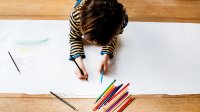13 Picture Books That Model Solitary Play
Independent play helps young learners grow self-awareness and self-management skills.
Your content has been saved!
Go to My Saved Content.The Big Orange Splot, by Daniel Pinkwater, is my favorite picture book. Mr. Plumbean lives in a neighborhood where all of the houses are the same. Inspired one day, he goes about transforming his house into a flamboyant dream home, which is very unsettling for his neighbors: “My house is me and I am it. / My house is where I like to be / and it looks like all my dreams.”
One by one, each neighbor visits Mr. Plumbean in an effort to persuade him to change his house back to the way it was, but ultimately, they too transform their houses into their own dream homes. The end result is that a group of identical houses is transformed into an extraordinary neighborhood of one-of-a-kind houses—each celebrating a member of a unique community.
Why is this my favorite picture book? First of all, Mr. Plumbean’s house is really cool. Second and more important, Mr. Plumbean is a true hero: He is a visionary who is passionate, creative, industrious, and a good listener. He’s a quiet yet bold community leader who inspires each person in his community to be true to themselves. Mr. Plumbean is also a master of independent or solitary play.
A key component of social and emotional learning is the focus on the development of self—in particular, self-awareness and self-management. Educators of young children recognize the importance of nurturing each child as an individual while also helping them see themselves as integral members of the classroom community.
The many benefits of independent play
Children who have ongoing opportunities to engage in independent or solitary play can build skills and strategies that enhance their self-awareness and self-management, and that foundation of understanding benefits everyone in the classroom.
Solitary play:
- Provides an individualized investigation into personal interests
- Can inspire other children’s play
- Can be a strategy for pivoting away from a social play situation that isn’t gratifying
- Provides a restorative break from collaborative play
- Is foundational to successful home-based play
- Provides essential opportunities for self-examination, self-evaluation, and problem-solving
The book list below features children engaged in solitary play (e.g., writing, building, pretending). In this collection, all of the children are happily engaged in independent activities fueled by their imagination, resourcefulness, and creativity. Reading these books as a collection assures children that independent or solitary play is a more than acceptable choice in the classroom.
This collection of books can be suggested reading for parents and caregivers over extended school breaks when children need ideas and strategies for pivoting from primarily socialized classroom play to independent or solitary play.
12 More books that feature solitary play
Rain, by Carol Thompson; and Snow, by Carol Thompson. Two board books from Carol Thompson’s series Whatever the Weather feature young children engaged in outdoor independent play. (Preschool)
Night Knight, by Owen Davey. A before-bed routine can seem routine and anticlimactic, but not for this little boy, who has a big imagination and a love for knights, castles, and dragons. (Preschool–kindergarten)
The Snowy Day, by Ezra Jack Keats. First published in 1962, this classic Caldecott Medal–winning book features Peter and his snowy-day adventures. The Ezra Jack Keats Foundation offers a read-aloud for this book. (Preschool–kindergarten)
Jack the Builder, by Stuart J. Murphy, illustrated by Michael Rex. Jack builds a robot, a hot dog stand, and a rocket ship with a set of colored blocks. This book is from the MathStart series (Level 1). (Preschool–grade 2)
My Forest Is Green, by Darren Lebeuf, illustrated by Ashley Barron. A little boy shares the year-round sights, sounds, and smells of the urban forest that he loves, as well as the forest he has created in his art studio at home. (Preschool–grade 2)
This Is Ruby, by Sara O’Leary, illustrated by Alea Marley; and This Is Sadie, by Sara O’Leary, illustrated by Julie Morstad. These two books feature young girls who are self-assured, independent, resourceful, and imaginative. (Preschool–grade 2)
All Alone, by Kevin Henkes. In author/illustrator Kevin Henkes’s first book, a young boy enjoys being alone outside and considers things big and small, including himself. (Preschool–grade 2)
Doll E 1.0, by Shanda McCloskey. Charlotte is happily living her best techno-life, when one day she receives a doll. The doll does very little, but with Charlotte’s help, and some big ideas, Charlotte transforms Dolly into Doll-E 1.0. Shanda McCloskey created corresponding activities for this book. (Preschool–grade 3)
Look! I Wrote a Book! (And You Can Too!), by Sally Lloyd-Jones, illustrated by Neal Layton. A young author shares unique (and frankly hilarious) dos and don’ts for being an author/illustrator. Author Sally Lloyd-Jones offers a story planner on her website. (Preschool–grade 3)
Wave, by Suzy Lee. In this wordless book, a little girl at the beach plays with a wave that keeps her on her toes. (All ages)
